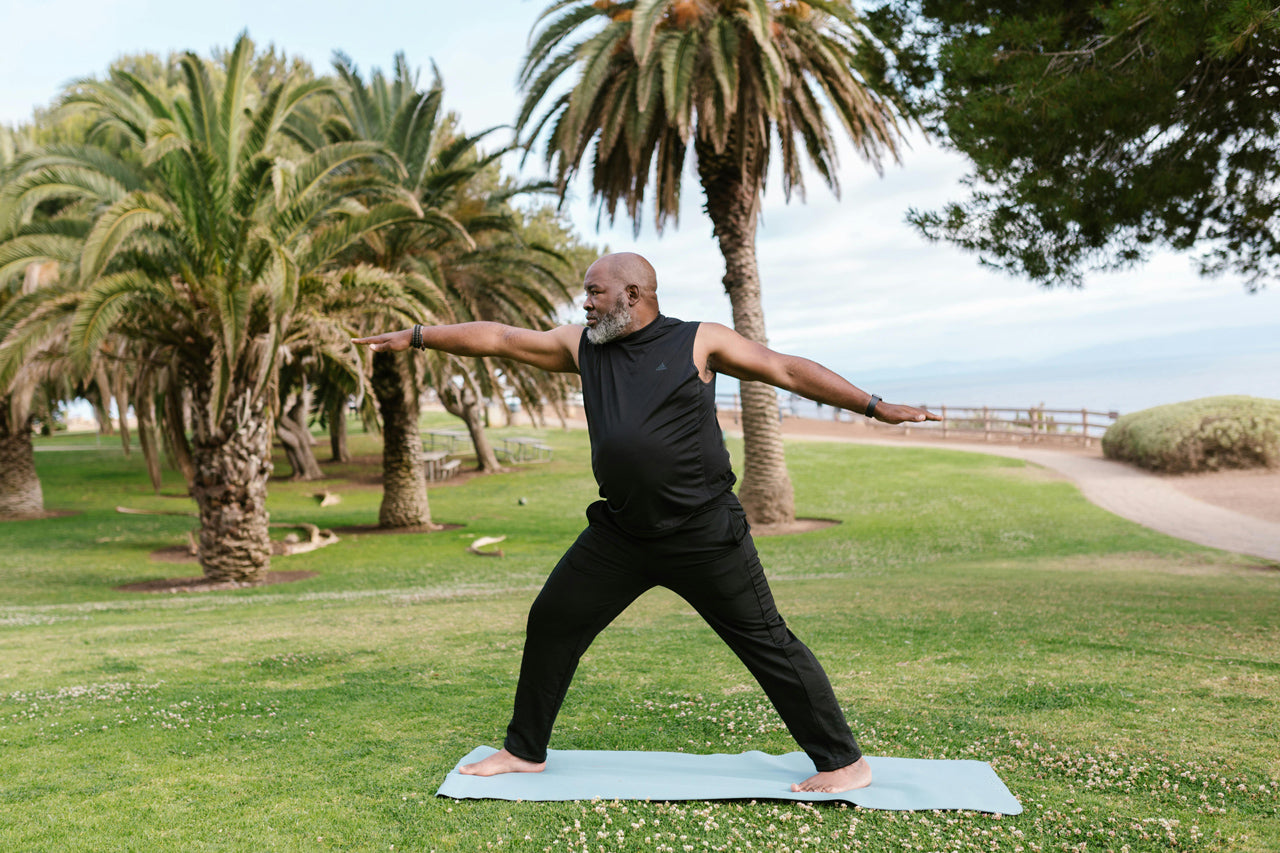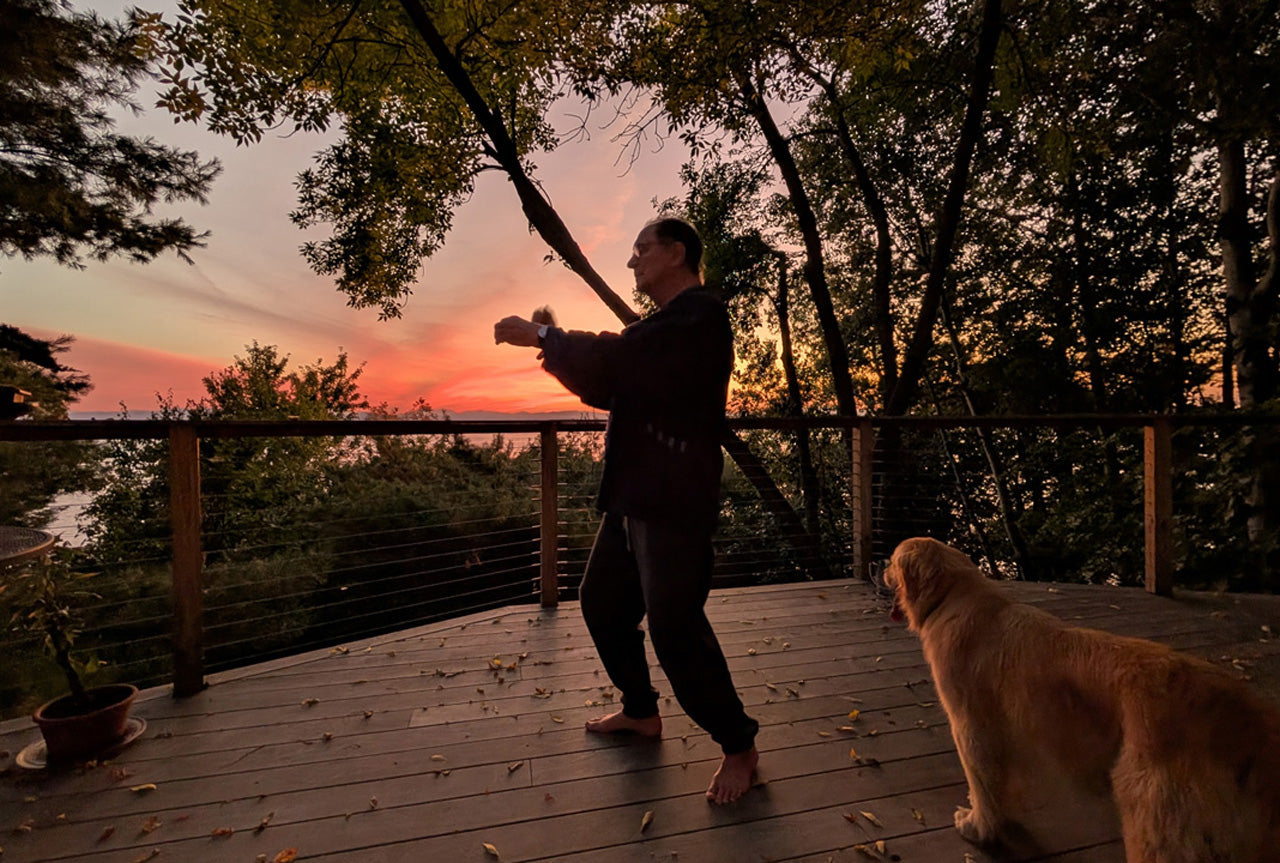Grip Strength, One Leg Standing, and the Sit to Stand Test
Three simple, at home tests provide insight into how long, and how well, we’re likely to live. Fortunately, our futures are not immutable, and so these tests can also be a wakeup call to optimize our health and longevity.
We humans have long sought something that distinguishes us from all other animals, a need that has led philosophers over the millennia proposed many different criteria that might set us apart as a species. Aristotle famously felt we were the only moral animal (“man alone has any sense of good and evil, of just and unjust.”), but others felt we were the only thinking animal, or the only tool making animal, or the only speaking animal. Each of these ideas faded as we came to better understand just how talented our fellow species really are. And evolutionary biologists point out that because we humans are just a very recent tweak on how life works, the idea that we are entirely unique in some way is actually unlikely. Rather, we've simply further developed abilities that other species share.
But in one regard we humans may actually stand alone. Humans do seem to be the only species aware of their own eventual mortality. A dog may worry about what's for dinner, but doesn’t reflect on his demise. By way of contrast, children by age 9 understand the key aspects of death: universality, irreversibility, inevitability, causality, and cessation of bodily functions.
And it’s not just kids. Death is actually a source of concern for most adults. The recent Covid epidemic showed us that over 50% of adults experience moderate to severe death anxiety during crisis periods, and even in non-crisis times, 3-10% experience clinically significant levels of concern about death.[i]
Our interest in our personal mortality has led us naturally to try to predict our lifespan. From ancient oracles to modern actuarial tables, we've sought to know how much time we have left. A good deal of progress has been made on this problem, and some surprises have emerged. For example, it turns out that some of the most powerful predictors of longevity are surprisingly simple physical tests that can be done without a doctor or even much equipment.
Three Tests That Predict How Long You'll Live
Researchers have identified a few simple physical performance tests that are strongly correlated with mortality. These basic measures of strength, balance, and functional capacity go a long way toward predicting our current biological age and with it our future health prospects.
Grip Strength: The Newest Vital Sign
Grip strength has emerged as one of the best predictors of health outcomes across populations. The international PURE study of 139,691 participants across 17 countries found that each 5 kg reduction in grip strength was associated with a 16% higher risk of all-cause mortality and a 17% higher risk of cardiovascular mortality. Even more striking, grip strength outperformed systolic blood pressure which previously had been one of the best predictors of these outcomes.[1][2] With minimal assumptions, grip strength data can be reformatted to predict, for example, a 60-year old’s remaining years to be lived. (As usual, women live longer than men for reasons that are not well understood.):

In a further confirmation of the power of grip strength, a massive UK Biobank analysis of over half a million adults confirmed these findings. Lower grip strength predicted higher all-cause mortality and cause-specific mortality from cardiovascular and respiratory diseases. Adding grip strength to standard clinical risk scores improved their predictive accuracy. Among patients with established heart disease, weaker grip strength independently predicted cardiac death, all-cause death, and heart failure hospitalization.[3][4][5]
Although this test does require piece of equipment called a hand dynamometers, it is relatively inexpensive (available from Walmart for under $20), it’s the easiest test to perform: simply squeeze as hard as you can and read the result in pounds or kilograms. Then consult a chart to see where you stand among your peers.
Why should such a simple test work so well? Grip strength seems to be a window into the body's overall biological state. Muscle is our largest metabolic organ, and maintaining it requires adequate protein intake, sufficient exercise, healthy hormonal signaling, intact motor neurons, and well controlled inflammation. When these systems degrade, strength declines, making grip strength a sensitive barometer of cumulative physiologic stress across organ systems.[3]
The One-Leg Stand: Balance as a Marker of Mortality
The ability to stand on one leg for 10 seconds is another simple but powerful predictor of survival. A study of 1,702 adults aged 51-75 found that people unable to complete this test had an 84% higher risk of death over the subsequent decade.[6][7][8]
The test itself is straightforward: stand on one leg for 10 seconds without additional support, with the free foot placed on the back of the opposite lower leg and arms at your sides. The ability to do these decreases dramatically with age—only 5% of people aged 51-55 fail the test, but the fail rate jumps to over 50% for those aged 71-75.[8]
In one study during the seven-year follow-up period, 17.5% of those who failed the balance test died, compared to only 4.6% of those who passed. Statistical modeling confirmed that the single leg standing test was an independent predictor of mortality even after accounting for age, sex, BMI, and medical conditions like diabetes and heart disease.[7][9][8]
Balance deteriorates relatively rapidly after age 60, unlike aerobic fitness and muscle strength which decline more gradually. This makes balance testing a uniquely sensitive marker of accelerated aging and frailty. The test also captures multiple physiological systems—sensory integration, motor control, muscle strength, and cognitive function—all working together to maintain postural stability.[10][6]
To easily test yourself at home, but if you’d like company, you can follow along with this video from the Mayo Clinic:
The Sit-to-Stand Test: Rising to the Challenge of Longevity
Perhaps the most dramatic mortality predictor is the sitting-rising test (SRT), where participants sit on the floor and rise to standing using as little support as possible. Although simple, this simple assessment has profound implications for survival.
In the original landmark study, participants started with 5 points each for sitting down and then rising (total of 10), with points subtracted for each support used (hand, knee, forearm) and half-points deducted for unsteadiness. A recent large-scale follow-up study of 4,282 adults aged 46-75 tracked participants for over 12 years and found striking mortality differences based on SRT scores.[11][12][13] For example, death rates were 3.7% for those achieving a perfect score of 10, but this tripled to 11.1% for those scoring 8, and increased to 42.1% for those scoring 0-4. After adjusting for age, sex, BMI, and medical conditions, those with the lowest scores had an almost 4-fold higher risk of natural death and a 6-fold higher risk of cardiovascular death compared to those with perfect scores.[12][11]
This test integrates multiple fitness components—muscular strength and power, flexibility, balance, and body composition—into a single, easily administered assessment.[11][12]
Here are a few examples of people doing the sit-to-stand test collected by the Washington Post:
Enter the Superagers: Defying the Odds
“Super agers” are defined by Dr. Eric Topol as people who live beyond 80 years and remain free from major chronic diseases such as cancer, cardiovascular disease, diabetes, stroke, and dementia—conditions that account for 90% of deaths in industrialized nations. Drawing from data on over 1,400 participants aged 80-105 that participated in his "Wellderly" study, Topol surprisingly found these people possessed no significant genetic advantages compared to typical aging populations. Instead, the wellderly cohort was characterized by lifestyle factors such as higher physical activity levels, better education, stronger social connections, and positive psychological attitudes. The study's surprising genetic findings suggest that healthful aging is more achievable than previously thought, with Topol noting "We can pretty much all do better" at preventing age-related diseases through evidence-based lifestyle interventions rather than hoping for genetic luck. This research has fundamentally shifted our understanding from genetic determinism toward a menu of modifiable factors that are involved in healthy aging. [1][2][3][4][5][6][7][8][9]
The Biological Integration
These findings converge on a central truth: our bodies are integrated systems, and simple physical tests can reveal the state of that integration. Grip strength reflects muscle mass, neural function, hormonal health, and inflammatory status. Balance testing captures sensory processing, motor control, cognitive function, and postural stability. The sit-to-stand test integrates strength, flexibility, balance, and coordination. Superagers are picked out by these tests, because these tests pick out characteristics associated with longevity.
Cause or Effect?
Although better performance on these tests is strongly associated with longer remaining lifespan, it’s unlikely that practicing or training to improve scores on these tests will actually lengthen one’s lifespan. This may seem counterintuitive, but the question can be phrased like this: “Does having a stronger grip make you live longer, or is it simply that those destined to live longer have a stronger grip?” In short, which way does the arrow of causality actually point?
As a lifelong medical researcher, I’m convinced that these tests predict, but do not create, one’s future. They are simply indicators of one’s underlying health. Training for a stronger grip won’t, indeed can’t, extend one’s lifespan. “Teaching to the test” may get produce a better score, but it undermines what the test can tell us.
In this way these tests are like the Spirit of Christmas Yet to Come that visited Scrooge in Dickin’s A Christmas Carol. Scrooge asks the spirit “Are these the shadows of the things that will be, or are they shadows of things that may be, only?” Scrooge continues hopefully: “Men's courses will foreshadow certain ends, to which, if persevered in, they must lead. But if the courses be departed from, the ends will change.” Just so with our three tests: they predict a future that is likely absent intervention. But we are all free to intervene.
The real value of these tests is that they can serve as a warning that one may need to eat better or exercise more or spend more time with friends or improve one’s sleep schedule. Optimizing these aspects of one’s life may then, slowly, organically, over time improve one’s chances of living a longer life, a change that will in turn improve scores on these three simple tests of health.
The Clinical Imperative
As a physician, I think these tests can be a part of routine medical assessments for adults over 50. They're quick, inexpensive, require almost no special equipment, and provide immediate, intuitive, prognostic information. More importantly, poor performance opens the door to a conversation about interventions that can extend not just lifespan, but healthspan—the years patients can expect to remain independent and vital. A stronger grip, better balance, and the ability to get up from the floor without assistance aren't just markers of longevity—they're prerequisites for maintaining independence and dignity as we age.
Our uniquely human awareness of mortality may seem a little depressing, but it can be a powerful motivator. These three simple tests can offer convenient reality checks, and perhaps encourage changes that lead to a healthier, longer future life. We may not be able to predict exactly how long we'll live, but we can influence how well we'll live for whatever time we have.
It’s a given that we will all age. The question is, can we become superagers?
- Leong DP, Teo KK, Rangarajan S, Lopez-Jaramillo P, Avezum A Jr, Orlandini A, et al. Prognostic value of grip strength: findings from the PURE study. Lancet. 2015;386(9990):266-73. doi:10.1016/S0140-6736(14)62000-6. PMID: 25982160. Link
- Leong DP, Teo KK, Rangarajan S, Lopez-Jaramillo P, Avezum A Jr, Orlandini A, et al. Prognostic value of grip strength: PURE study. Lancet. 2015;386(9990):266-73. Link
- Lau E, Dagfinrud H, Falch-Rasmussen J, et al. CFRD: a systematic review & meta-analysis. BMJ. 2018;361:k1651. PDF
- Celis-Morales CA, Welsh P, Lyall DM, et al. Grip strength & mortality: UK Biobank. BMJ. 2018;361:k1651. Link
- Pavasini R, Serenelli M, Celis-Morales CA, et al. Grip strength predicts cardiac events. Heart. 2019;105(11):834-41. doi:10.1136/heartjnl-2018-313816. Link
- Godman H. Better balance may mean a longer life. Harvard Health Publishing. 2022. Link
- Araujo CG, de Souza e Silva CG, Laukkanen JA, et al. 10-second one-leg stance & survival. Br J Sports Med. 2022;56(17):975-80. PMID: 35728834. Link
- Madson R. Single-leg stance as mortality indicator. Neurology Advisor. 2022. Link
- Araujo CGS. One-leg stance & mortality. Br J Sports Med. 2022. Link
- EurekAlert! Balance linked to doubled death risk. 2022. Link
- Araújo CGS, de Souza e Silva CG, Myers J, et al. Sitting–rising test & mortality. Eur J Prev Cardiol. 2025. Link
- Araújo CGS, de Souza e Silva CG, Myers J, et al. Sitting-rising test predicts mortality. Eur J Prev Cardiol. 2025. PMID: 40569873. Link
- Brito LBB, Ricardo DR, de Araújo DSMS, et al. Sit-rise ability predicts mortality. Eur J Prev Cardiol. 2014;21(7):892-8. Link
- Samuelson K. What makes a SuperAger? Northwestern Now. 2025. Link
- ALZinfo.org. What SuperAgers teach us. 2025. Link
- Weintraub S, Gefen T, Geula C, Mesulam MM. Northwestern SuperAging Program. Alzheimers Dement. 2025. Link
- Garo-Pascual M, Gaser C, Zhang L, et al. Brain structure of SuperAgers. Lancet Healthy Longev. 2023. Link
- American Senior Communities. SuperAger traits. 2025. Link
- Northwestern Medicine. 4 habits of SuperAgers. 2023. Link
- Garo-Pascual M, Gaser C, et al. SuperAger brain study. Lancet Healthy Longev. 2023. Link
- Roberts J. Sit-stand test predicts longevity. Fortune. 2023. Link
- RACGP. Balance test shows death risk. 2022. Link
- Mayo Clinic. One-leg test & longevity. 2024. Link
- Repnitskaya S. Fitness test reveals lifespan. Health.com. 2025. Link
- Cleveland Clinic. 10-second balance test. Health Essentials. 2022. Link
- Jamshed N. Secrets of SuperAgers. UTSW MedBlog. 2024. Link
- El Camino Health. Sitting-rising test. 2024. Link
- National Institute on Aging. Cognitive SuperAgers. 2017. Link
- Garcia-Aguirre M, Baltasar-Fernandez I, Alcazar J, et al. Sit-to-stand power & mortality. J Sport Health Sci. 2025. Link
- Jefferson Health. Balance & lifespan. 2023. Link
- InterHospi. 25-year SuperAger study. 2025. Link
- de Brito LBB, Ricardo DR, et al. Sit-rise test predicts mortality. Eur J Prev Cardiol. 2012. PDF
- Bernabeu-Mora R, et al. 5× sit-to-stand & COPD mortality. Arch Bronconeumol. 2025. Link
- Polo-López A, López-Bueno R, Calatayud J, et al. Chair-stand & mortality in older adults. Maturitas. 2025. Link
- Núñez-Cortés R, Andersen LL, Cruz-Montecinos C, et al. Chair-stand vs grip strength for mortality prediction. Braz J Phys Ther. 2025. Link
- Araújo CG, de Souza e Silva C, et al. Balance test & survival. BJSM Blog. 2022. Link
- Weintraub S, Gefen T, Geula C, Mesulam MM. Northwestern SuperAging Program. Alzheimers Dement. 2025. Link
- Tsubaki Y, Kamiya K, Hamazaki N, et al. 5× sit-to-stand & prognosis in CVD. Eur Heart J. 2024. Link
- Araujo CG, de Souza e Silva CG, et al. 10-second stance predicts survival (PDF). Br J Sports Med. 2022. PDF




Leave a comment
All comments are moderated before being published.
This site is protected by hCaptcha and the hCaptcha Privacy Policy and Terms of Service apply.